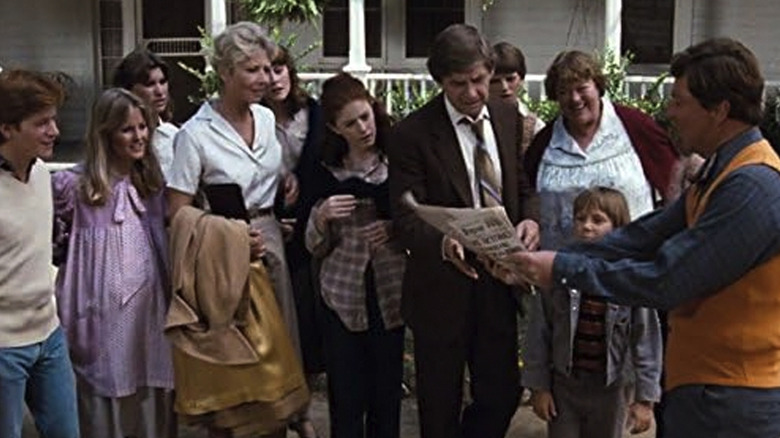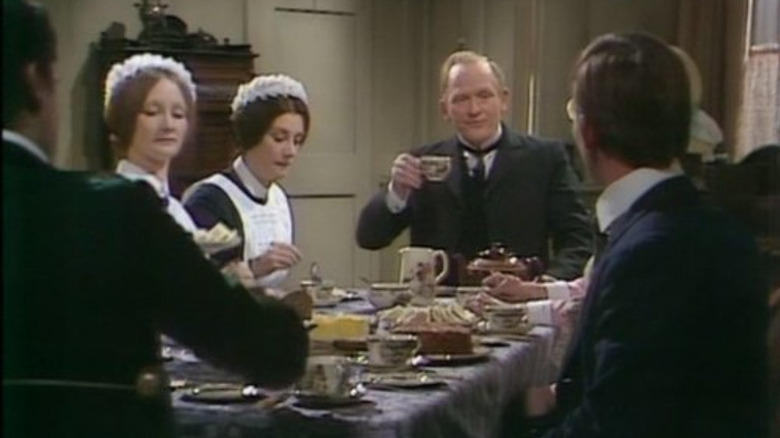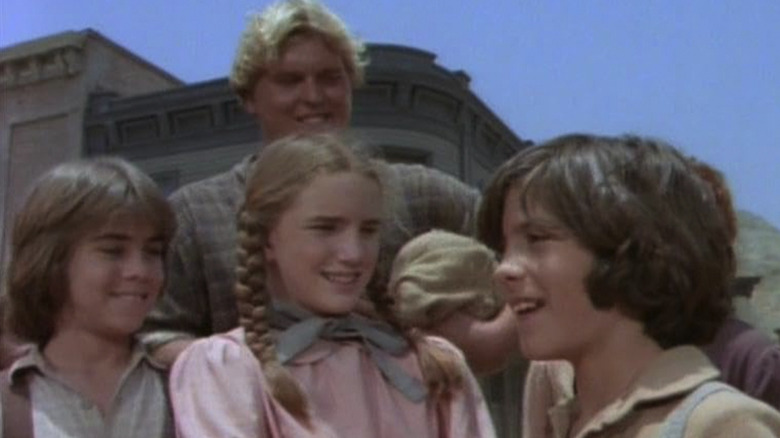5 Hit '70s TV Shows That No One Remembers Today
Everyone has their own definition of the "Golden Age of Television." Some still put it in the 1960s, as color TV became standard and the airwaves were flooded by classics, from "Star Trek" and "Mission: Impossible" to "Bonanza," "Gilligan's Island," and "The Dick Van Dyke Show." Others point to the explosion in "prestige" TV in the 2010s, a decade defined by shows like "Game of Thrones" and "Breaking Bad."
No matter your own definition, it's hard to deny the importance of the 1970s. It was a decade of innovation, of pushing boundaries, where the sitcom became just as much a venue for political commentary as for humor. Shows like "M*A*S*H," "Good Times," and "All in the Family" dominated the decade by striking that balance, handling topics like racism, economic inequity, and the military-industrial complex through top-tier comedy writing. On the action side, shows like "The Rockford Files" and "Starsky and Hutch" helped set the stage for the modern crime genre born in the '80s and '90s.
Many of the most popular TV shows of the '70s have stayed active in the cultural zeitgeist through reboots, remakes, or simply because of their historical acclaim. But it was a crowded decade on the small screen, and many more series have been forgotten. Today, we're revisiting a handful of those neglected hits — shows that earned huge attention in their day and influenced decades of television to follow, but which are rarely brought up these days.
If you grew up on these in their day, or on reruns, you'll know them well, and many others may know the names. But as time marches on and weeds grow on the grave of rerun culture, their memory continues to fade. For this specific list, we prioritized shows with long, successful runs, but which have since been relegated to the annals of TV history.
The Waltons
Starting our list is a show that practically opened and closed the decade. "The Waltons" premiered with a TV movie in December 1971, and that success led to a series order that kicked off the following September. Set during the Great Depression in a small Appalachian Virginia town, the series is primarily a family drama following the titular clan and their surrounding community through economic hardships, illness, and later on, World War II.
The show ran for a titanic nine seasons, wrapping up in 1981. A series of TV films followed, carrying the story forward all the way to 1997, when the last movie aired.
While "The Waltons" has historically been remembered as a sappy portrait of "traditional family values," modern readings put it closer to the more politically subversive shows of the '70s than you might expect. Yes, there's a lot of bootstraps Americana in here, but there's also powerful messaging around environmental preservation, tolerance, and communalism. And while the series still functioned on a then-standard episodic format, it had a noteworthy narrative progression in macro, with real time passing steadily, the Walton children growing into adulthood, and history always anchoring the interpersonal plots.
These days, even the once-famous "Goodnight, John Boy" that ended most episodes is essentially gone from the pop culture parlance. Timeless "The Waltons" may not be, but it's a show well worth remembering.
The Six Million Dollar Man
Science fiction was still a burgeoning genre on television in the early '70s. Despite the existence of classics like "Star Trek," "Doctor Who," and "The Twilight Zone," budgets and effects technology of the day made it challenging to put much scale within the genre on the screen, and the shows that did hit often hit briefly. (It's worth remembering that while it became a staying power in syndication during the '70s, "Star Trek" only lasted three seasons and received poor viewership during its initial run.)
That's all to say that "The Six Million Dollar Man" was far from a guarantee when it premiered on ABC in 1973, though its format made it a bit more standard for the era. The eponymous bionic hero, played by Lee Majors, operates more in the "Mission: Impossible" vein, and he became a big hit in the superhero TV wave of the '70s, which also included shows like "The Incredible Hulk" and "Wonder Woman."
A smash in its day, "The Six Million Dollar Man" spawned a spin-off, "The Bionic Woman," which ran for three seasons on its own, and a series of TV films in the '80s and '90s. Of all the shows listed here, this is probably the one with the biggest franchise footprint, and there have been rumors for years of a modern "Six Million Dollar Man" revival, which could pull the original series out of the thrift store VHS bin. For now, though, the show's reputation with today's audiences remains largely nonexistent.
Sanford and Son
As I mentioned, the '70s was a decade of great innovation for the TV sitcom, but one of the decade's biggest hits doesn't get anywhere near the attention these days that its contemporaries still receive. "Sanford and Son" is about as narrow in focus as a show can be, following the lives of cantankerous junkyard proprietor Fred Sanford, played by the inimitable Redd Foxx, and his straight-man son Lamont, played by Demond Wilson. Around that core duo rotated an extended cast of supporting characters, most of whom serve as fodder for Foxx's endless wit and character mastery.
While not as critically acclaimed (and therefore more easily forgotten) as shows like "All in the Family" or "Good Times," "Sanford and Son" covers similar material, with the whole show taking place in Los Angeles' Watts neighborhood and frequently dealing with the many colliding political fronts of the time.
Still, the real appeal here is Foxx, who's been sadly left behind in most casual discourse on the great comedians of his era. An incredible talent, he's the centerpiece around which the entire show rotated for six seasons, during which time it frequently scored in the Nielsen top 10.
Upstairs, Downstairs
Jumping across the Atlantic from the primarily American shows on this list, we have to give a shout to ITV's "Upstairs, Downstairs," which ran for five series in the first half of the decade. It's the sort of show that's become quite common and popular over the last couple of decades via the British TV to global audience pipeline — a period drama focused on class divisions and the impact of major historical events.
You're probably thinking now of "Downton Abbey," and for good reason. Both shows take place in the early 20th century, charting the shift of British society from a more formal divide between working class and aristocracy to something more modern and technologically advanced as the World Wars and Great Depression loom. "Upstairs, Downstairs" is set in London, however, where "Downton" takes place at the eponymous country estate.
Looking around at the Julian Fellowes cinematic universe and its many imitators, it's easy to feel the impact of the '70s series, even as fewer and fewer people remember it ever aired. A revival series aired from 2010-2012, but it never gained much traction, and it certainly didn't supplant the importance of the original.
Little House on the Prairie
There are a lot of similarities between "Little House on the Prairie" and "The Waltons." Both are historical family dramas that focus on the hardship of certain mythologized American times and places. Both ran for nine seasons, though "Little House" started a bit later and therefore spilled out a bit deeper into the '80s.
Based on the books by Laura Ingalls Wilder, the show follows the Ingalls family through the ups and downs of homesteading in Minnesota in the late 19th century. Brutal winters, sickness, and other external forces serve as frequent foes, but the family and surrounding community always bands together to endure.
The show carried some popularity from the Western genre's dominance in the previous TV era, with Michael Landon, who made his fame on "Bonanza," playing the Ingalls family patriarch. However, the tone is different overall, and the show can't be neatly categorized in the same "Western" format as the hits of the '50s and '60s. As on "The Waltons," the children grow up over the course of the series, with Laura (Melissa Gilbert) eventually getting married and moving into the primary protagonist role.
"Little House on the Prairie" is still talked about from time to time in historical discussions of the era on television, but as the years have passed, the original books remain the thing most people think of when the name is mentioned. That's probably correct in the end, but the show was an absolute titan in its day.





